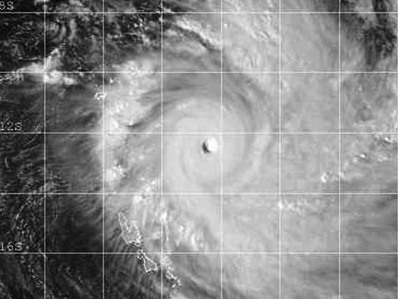
The 2012/2013 tropical cyclone season has been a busy one and we have not yet reached the peak of the season. Two strong depressions and two severe tropical cyclones have brought destruction and, sadly, some deaths to the South Pacific. As this article is being written, a third cyclone has narrowly missed the Samoas.
 With average or slightly below average rainfall through the spring months of September and October, some countries and territories in the region were looking for rain to boost drinking supplies and help farmers with their crops. Their prayers were answered in November, especially during the latter weeks, when rainfall picked up over Melanesia and we saw the first tropical system develop west of Rotuma near northern Vanuatu around the 20th. This event coincided with a burst of weather across the western South Pacific that brought some welcome rains to Papua New Guinea, Solomons and Tuvalu, and parts of Fiji.
With average or slightly below average rainfall through the spring months of September and October, some countries and territories in the region were looking for rain to boost drinking supplies and help farmers with their crops. Their prayers were answered in November, especially during the latter weeks, when rainfall picked up over Melanesia and we saw the first tropical system develop west of Rotuma near northern Vanuatu around the 20th. This event coincided with a burst of weather across the western South Pacific that brought some welcome rains to Papua New Guinea, Solomons and Tuvalu, and parts of Fiji.
This system ultimately became Tropical Depression 02F and, while not quite making it to tropical cyclone status, it did move along the Vanuatu archipelago bringing locally heavy rain with only minor impacts, mostly flash flooding. After TD02F things went quiet again for a few weeks, however, by the end of the first week of December, it was evident there was going to be a flurry of activity as the first Madden Julian Oscillation [see box] wave passed into the Pacific and spawned Tropical Cyclones Evan and Freda. Both of these systems reached Category 4 intensity, i.e. a Severe Tropical Cyclone, and both affected land areas. Of the two, Evan was the most destructive, as it moved across Samoa, Wallis and Futuna islands, and finally Fiji, causing millions of dollars damage and, sadly, in Samoa, the loss of several lives.
The impacts of Severe TC Evan will be felt for many years in Fiji and Samoa, with damage to houses, infrastructure, crops and businesses totaling many millions of dollars and several thousand people left homeless and without income or jobs. We know from past experience that the economic impacts of cyclones can be long lasting and severe, and mitigating these losses is a major focus of attention right now in Pacific Island Countries. The Secretariat of the Pacific Regional Environment Programme, the Secretariat of the Pacific Community and the Pacific Islands Forum Secretariat are working to assist member countries and territories incorporate natural disaster risk planning into integrated national plans for managing socio-economic and environmental risk in order to ensure that appropriate mitigation strategies are built into future projects to diminish losses from natural hazards such as floods and tropical cyclones.

With the season less than half over, there is still the prospect of much more activity. February is the month with the highest incidence of tropical cyclone formation in the Pacific region and signs of increased activity are evident for the second half of January. There are still three and a half months left of the season and we are likely to experience the 9 named cyclones predicted by NIWA for this region in that time. It is also expected that, with two cyclones already reaching Category 4 intensity, the forecast of three severe cyclones is likely to be exceeded.
All Pacific islanders need to remain alert to the threat of heavy rain and destructive winds during tropical cyclones. Those most vulnerable to the impacts of cyclones, especially those in small craft such as fishermen or ferry operators between small islands, MUST take heed of warnings such as small boat advisories well before a cyclone is due to hit land. Regrettably many who lost their lives during TC Evan were operating small craft when warnings for hazardous weather had been issued. Whenever any threats arise, listen for local advisory messages from your weather office and disaster management office, and follow instructions of local authorities.